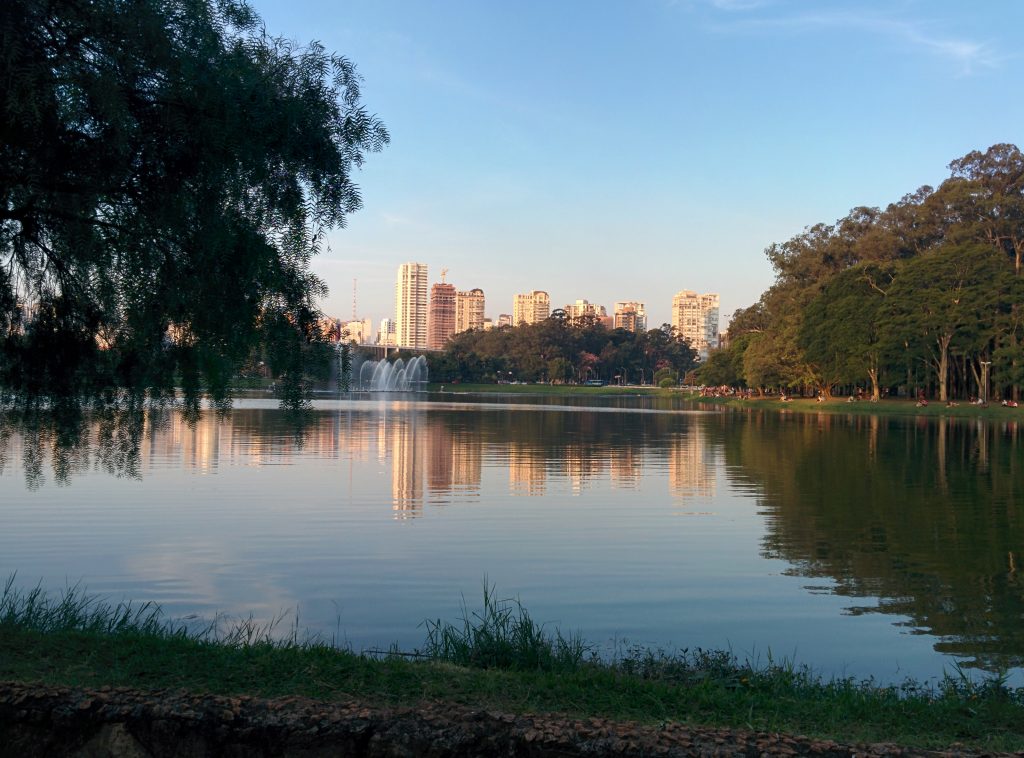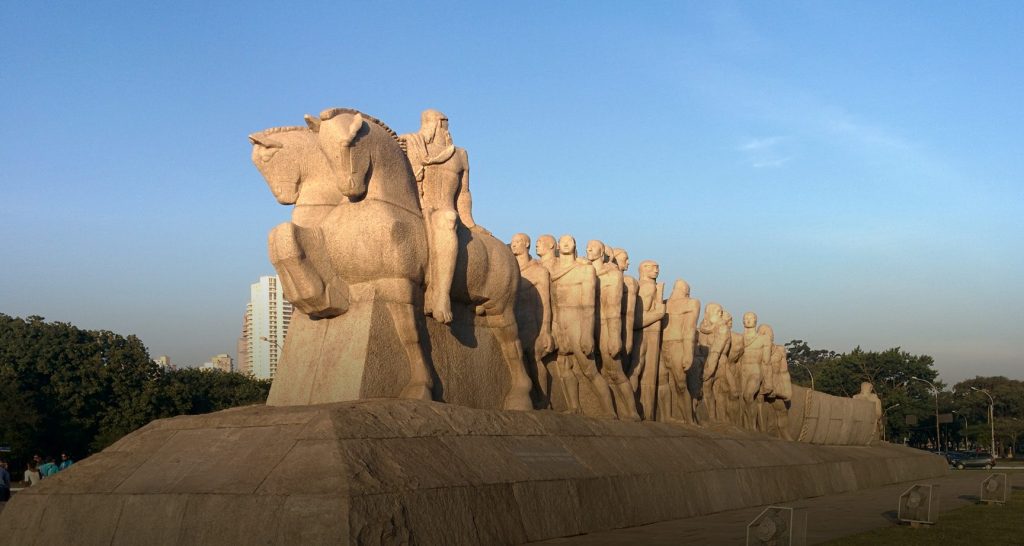Ibirapuera Park (Portuguese: Parque Ibirapuera) is a major urban park in São Paulo, Brazil is a mix of culture and health activities. It has a large area for leisure, jogging and walking, as well a vivid cultural scene with museums and a music hall.
Inaugurated in 1954 for the 400th anniversary of the city, with buildings designed by famous architect Oscar Niemeyer and landscape by agronomist Otávio Agusto de Teixeira Mendes, Ibirapuera Park covers an area of almost 2 square kilometres (0.77 sq mi). It is the second largest park in the city. Admission is free.
The park complex contains several buildings, most of them designed by Oscar Niemeyer.
They include:
The Marquise (“marquee”) is a large construction that links Bienal, Auditório Ibirapuera and Oca. It’s used now as a place for people to relax, skate, and rollerblade.
Gate/Portão 1 and 2.
The Cicillo Matarazzo Pavilion is spacious building that host the São Paulo Art Biennial and the São Paulo Fashion Week;
Gate/Portão 10
The Manoel da Nóbrega Pavilion, which until 1992 was the city hall and now houses the “Museu Afro Brasil”.
Museu Afro Brasil is a public institution, held by São Paulo State Secretariat for Culture and managed by Associação Museu Afro Brasil – Organização Social de Cultura (Museu Afro-Brasil Association – Social Organization for Culture)
It aims to be a contemporary museum where the black people can be recognized.
Over than 6,000 works highlight the importance of African people in the formation of Brazilian culture, heritage and identity as known nowadays. Also, it offers a celebration of the art and accomplishments of the Africans and Afro-Brazilians.
The Collection is considered the largest Afro – American in American with more than 6,000 masterpieces, sculptures, documents, engravings, ceramics, paintings, contemporary arts, jewelry, objects, reliefs, photographs and textiles.
Over than 70% of the collection is in the long term exhibition, portraying mainly Brazil, some countries from the African Continent, Cuba, Haiti and the United States.
Gate/ Portão 10
Entrance: R$ 6,00 and Saturday Free
When: Tuesday to Sunday from 10am to 5pm.
The Lucas Nogueira Garcez Pavilion, formerly known as “Palácio das Exposições”(“Expositions Palace”) and now known as the Oca (“hut”, given its round shape), which harbors both the Museu da Aeronáutica (“Air Force Museum”) and the Museu do Folclore (“Folklore Museum”);
Gate/Portão 1 and 2
The Planetarium and Municipal Astrophysics School. The Planetarium building which is shaped like a flying saucer. It was the first Planetarium in the Southern Hemisphere and has a dome which is 20 meters in diameter. The German projection machine shows the sky above São Paulo from dusk to dawn. During the projection a professional astronomer explains the most famous stars and constellations as well as the movements of the Earth and other planets;
Session time: 40Min
When:
- Jan, Feb, Jul and Dec: Tuesday to Sundays and holidays , 4 daily sessions (10am/12am/3pm/5pm)
- Other months: only on the weekend, 4 daily sessions (10am/12am/3pm/5pm)
The Japanese Pavilion was built jointly by the Japanese government and the Japanese-Brazilian community and donated to the city of Sao Paulo in 1954, to commemorate the 400th anniversary of Sao Paulo.
The building’s material was shipped from Japan and its structure is a replica of the Katsura Palace in Kyoto and was built based on traditional Japanese architecture in the Shoin style, used in homes and the homes of the samurai aristocracy.
The main building has an exhibition hall with Japanese art, samurai clothes, pottery, sculptures and a tea room.
Next to the Japanese Pavilion is a Japanese-style garden full of plants and ornamental trees, and volcanic rock brought from Japan. There is also a pond full of carp, where you can come feed the fish.
Gate/Portão 10
When: Wednesday, saturday, sunday and holidays from 10am to 12am and 1pm to 5pm
Entrance: R$10 (full) and R$5 (students and seniors over 65 years)
Monument to the Bandeiras (O Monumento às Bandeiras) is a large-scale sculpture by the Italian-Brazilian sculptor Victor Brecheret (1894-1955) at the entrance of Ibirapuera Park in São Paulo, Brazil. It was commissioned by the government of São Paulo in 1921 and completed in 1954. The monument, given its size and location, has now become an integral part of the landscape of São Paulo.
The monument was erected in the south central area of the city in Armando Salles de Oliveira Square (Armando Salles de Oliveira Square), opposite the Palácio 9 de Julho, headquarters of the Legislative Assembly of the State of São Paulo.
The Obelisk of São Paulo (in Portuguese: Obelisco de São Paulo) or Obelisk of Ibirapuera (in Portuguese: Obelisco do Ibirapuera) is an obelisk in Ibirapuera Park in the city of São Paulo, Brazil.
This monument is a symbol of the Constitutionalist Revolution of 1932, and the biggest monument of the city of São Paulo. The height of the monument is 72 meters (236 ft 3 in). The construction of the monument was started in 1947 and completed in 1970.
The obelisk is a project of the Italo-Brazilian sculptor Galileo Ugo Emendabili, who arrived at Brazil in 1923. The obelisk, made with pure travertine marble, was inaugurated on July 9, 1955, one year after the inauguration of Ibirapuera Park.
Where: Av. Pedro Álvares Cabral – Moema
When: Daily from 5 am to 12 am.
Website: www.parqueibirapuera.org
Getting there: There isn’t a metro station near, depends where are you to go by bus or Uber/Taxi.

















